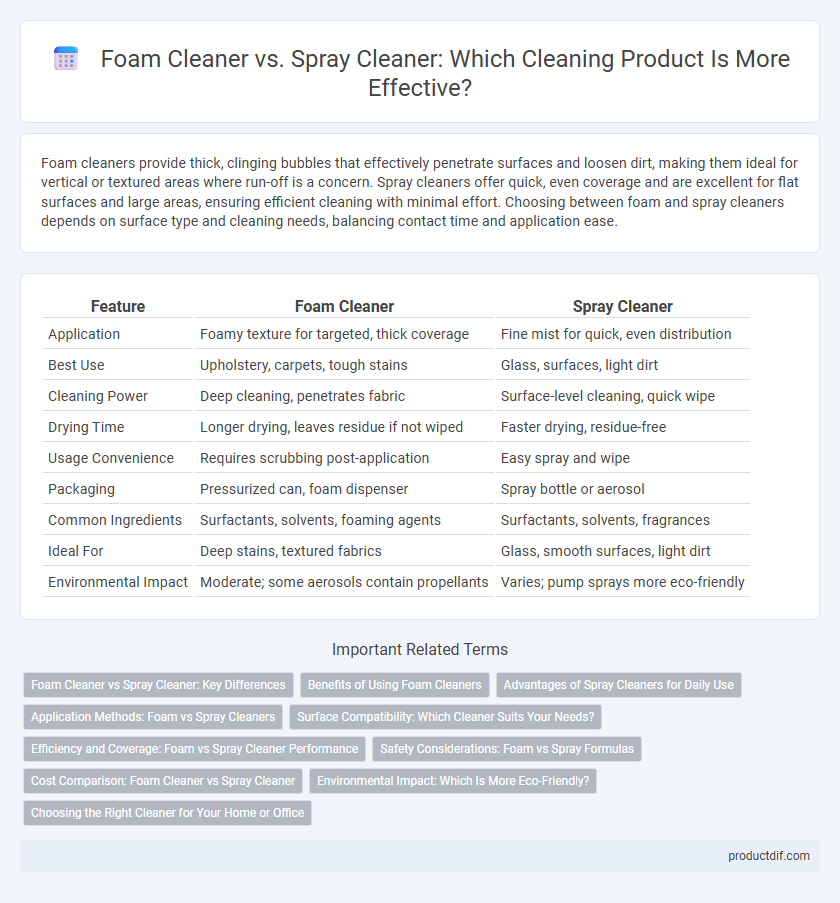Foam cleaners provide thick, clinging bubbles that effectively penetrate surfaces and loosen dirt, making them ideal for vertical or textured areas where run-off is a concern. Spray cleaners offer quick, even coverage and are excellent for flat surfaces and large areas, ensuring efficient cleaning with minimal effort. Choosing between foam and spray cleaners depends on surface type and cleaning needs, balancing contact time and application ease.
Table of Comparison
| Feature | Foam Cleaner | Spray Cleaner |
|---|---|---|
| Application | Foamy texture for targeted, thick coverage | Fine mist for quick, even distribution |
| Best Use | Upholstery, carpets, tough stains | Glass, surfaces, light dirt |
| Cleaning Power | Deep cleaning, penetrates fabric | Surface-level cleaning, quick wipe |
| Drying Time | Longer drying, leaves residue if not wiped | Faster drying, residue-free |
| Usage Convenience | Requires scrubbing post-application | Easy spray and wipe |
| Packaging | Pressurized can, foam dispenser | Spray bottle or aerosol |
| Common Ingredients | Surfactants, solvents, foaming agents | Surfactants, solvents, fragrances |
| Ideal For | Deep stains, textured fabrics | Glass, smooth surfaces, light dirt |
| Environmental Impact | Moderate; some aerosols contain propellants | Varies; pump sprays more eco-friendly |
Foam Cleaner vs Spray Cleaner: Key Differences
Foam cleaners provide thicker coverage and extended contact time, making them ideal for tackling stubborn stains and uneven surfaces, while spray cleaners offer quick application and are better suited for smooth, flat areas. Foam formulas often contain surfactants and polymers that cling to surfaces, enhancing deep cleaning and reducing runoff. Spray cleaners typically dry faster and require less scrubbing but may need repeated applications for heavy-duty grime.
Benefits of Using Foam Cleaners
Foam cleaners offer superior adhesion to surfaces, ensuring longer contact time and more effective removal of dirt, grease, and grime compared to spray cleaners. Their thick, clinging texture minimizes run-off, making them ideal for vertical surfaces and hard-to-reach areas. Foam cleaners also reduce chemical usage and waste, promoting a more environmentally friendly cleaning process.
Advantages of Spray Cleaners for Daily Use
Spray cleaners offer precise application, reducing waste and ensuring even coverage on surfaces, which is ideal for quick daily cleaning tasks. Their fast-drying formulas minimize residue, allowing for immediate use of cleaned areas without the need for rinsing. Compact and easy to store, spray cleaners provide convenience and efficiency for routine maintenance in homes and offices.
Application Methods: Foam vs Spray Cleaners
Foam cleaners provide thick, clinging bubbles that adhere to surfaces longer, allowing deep penetration into grime and dirt, making them ideal for vertical or porous surfaces. Spray cleaners disperse liquid evenly and quickly, facilitating easy coverage over large or flat areas, ideal for fast cleaning and rinsing. Choosing between foam and spray depends on the targeted surface type and cleaning intensity required.
Surface Compatibility: Which Cleaner Suits Your Needs?
Foam cleaners excel on vertical and porous surfaces, offering gentle yet effective cleaning without oversaturation, making them ideal for upholstery, carpets, and delicate electronics. Spray cleaners provide versatile application across hard, non-porous surfaces like glass, countertops, and stainless steel, allowing for quick coverage and easy rinsing. Choosing between foam and spray cleaners depends on surface texture and material sensitivity to ensure optimal cleanliness without damage.
Efficiency and Coverage: Foam vs Spray Cleaner Performance
Foam cleaners provide superior coverage by clinging to surfaces longer, allowing active ingredients to penetrate and loosen dirt effectively, which enhances cleaning efficiency on vertical and porous areas. Spray cleaners offer quick application and are ideal for light, everyday cleaning, but their liquid consistency can lead to quicker runoff and reduced dwell time, limiting deep cleaning effectiveness. Selecting between foam and spray cleaners depends on the cleaning task's intensity and surface type, with foam generally outperforming sprays in thoroughness and efficiency.
Safety Considerations: Foam vs Spray Formulas
Foam cleaners reduce airborne particles and minimize inhalation risks, making them safer for enclosed spaces compared to spray cleaners, which can disperse fine chemicals into the air. Spray formulas may increase exposure to volatile organic compounds (VOCs), posing respiratory hazards, especially in poorly ventilated areas. Foam cleaners also provide controlled application, reducing skin contact and chemical exposure, enhancing overall safety during use.
Cost Comparison: Foam Cleaner vs Spray Cleaner
Foam cleaners typically offer better cost efficiency due to their concentrated formula, which requires less product per use compared to spray cleaners that often dispense a larger volume. Spray cleaners may incur higher expenses over time because of frequent repurchasing and wastage from overspray. Choosing foam cleaner can reduce overall cleaning costs by maximizing product longevity and minimizing excess usage.
Environmental Impact: Which Is More Eco-Friendly?
Foam cleaners typically use less water and produce less volatile organic compounds (VOCs) than spray cleaners, resulting in a lower environmental impact. Spray cleaners often release aerosols that contribute to air pollution and increase greenhouse gas emissions. Choosing foam cleaners made from biodegradable and non-toxic ingredients can enhance eco-friendliness by minimizing chemical residues and packaging waste.
Choosing the Right Cleaner for Your Home or Office
Foam cleaners offer superior clinging properties, making them ideal for vertical surfaces and removing stubborn dirt in homes or offices. Spray cleaners provide quick application and ease of use, perfect for everyday cleaning tasks on flat surfaces. Selecting the right cleaner depends on surface type, cleaning frequency, and the level of grime present to ensure efficient and effective results.
Foam Cleaner vs Spray Cleaner Infographic

 productdif.com
productdif.com